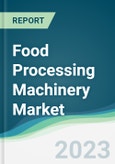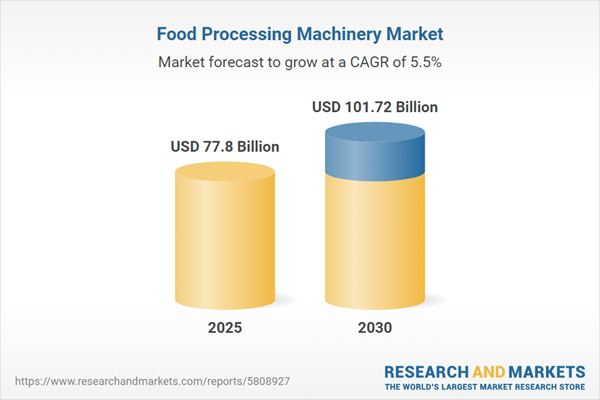The Food Processing Machinery Market Study provides a comprehensive analysis of the global food processing machinery market, offering industry experts critical insights into market trends, technological advancements, and competitive strategies shaping this vital sector. This study explores key market dynamics, including drivers, restraints, and opportunities, with detailed segmentation by application and geography. Designed to support strategic decision-making, the Food Processing Machinery Market Study equips stakeholders with data-driven forecasts, regulatory insights, and competitive intelligence to navigate the evolving landscape of food processing solutions.
Study Overview
The Food Processing Machinery Market Study examines the global food processing machinery market, segmented by application (Beverage Processing, Vegetable and Fruit, Meat/Poultry Processing, Bakery, Others) and geography (North America, South America, Europe, Middle East and Africa, Asia Pacific). It includes robust analyses such as Porter’s Five Forces Analysis, Industry Value Chain Analysis, and market share evaluations, alongside strategic recommendations and regulatory insights to help stakeholders capitalize on growth opportunities. The study highlights key driving factors, such as increasing demand for processed foods and automation, and challenges, including high equipment costs and stringent regulatory compliance.Competitive Environment and Analysis
In the competitive intelligence section of the Food Processing Machinery Market Study, key players are highlighted for their strategic initiatives to strengthen market presence. For instance,GEA Group
has recently introduced a new line of energy-efficient meat processing machinery with advanced automation features, enhancing throughput and sustainability for the meat/poultry processing sector. This development reinforces GEA’s position as a leader in innovative processing solutions. Similarly,Tetra Pak
has expanded its portfolio through a strategic collaboration to develop smart beverage processing systems integrated with IoT technology, optimizing production efficiency and traceability for the beverage industry. The study also includes market share analysis, mergers, acquisitions, and a vendor matrix categorizing players into leader, follower, challenger, and niche quadrants, providing a holistic view of the competitive landscape.Conclusion
The Food Processing Machinery Market Study is an essential resource for industry experts seeking to understand the complexities of the food processing machinery market. By offering detailed segmentation, technological outlooks, and competitive intelligence, this study provides a robust framework for identifying opportunities and formulating effective strategies. With leading players like GEA Group and Tetra Pak driving innovation in energy-efficient and smart processing solutions, the Food Processing Machinery Market Study empowers stakeholders to stay competitive in this dynamic and rapidly growing industry.Key Benefits of this Report:
- Insightful Analysis: Gain detailed market insights covering major as well as emerging geographical regions, focusing on customer segments, government policies and socio-economic factors, consumer preferences, industry verticals, and other sub-segments.
- Competitive Landscape: Understand the strategic maneuvers employed by key players globally to understand possible market penetration with the correct strategy.
- Market Drivers & Future Trends: Explore the dynamic factors and pivotal market trends and how they will shape future market developments.
- Actionable Recommendations: Utilize the insights to exercise strategic decisions to uncover new business streams and revenues in a dynamic environment.
- Caters to a Wide Audience: Beneficial and cost-effective for startups, research institutions, consultants, SMEs, and large enterprises.
What do businesses use our reports for?
Industry and Market Insights, Opportunity Assessment, Product Demand Forecasting, Market Entry Strategy, Geographical Expansion, Capital Investment Decisions, Regulatory Framework & Implications, New Product Development, Competitive IntelligenceReport Coverage:
- Historical data from 2022 to 2024 & forecast data from 2025 to 2030
- Growth Opportunities, Challenges, Supply Chain Outlook, Regulatory Framework, and Trend Analysis
- Competitive Positioning, Strategies, and Market Share Analysis
- Revenue Growth and Forecast Assessment of segments and regions including countries
- Company Profiling (Strategies, Products, Financial Information, and Key Developments among others).
Different segments covered under the food processing machinery market report are as below:
By Type
- Processing Equipment
- Pre-Processing Equipment
- Others
By Application
- Beverage Processing
- Vegetable and Fruit
- Meat/Poultry Processing
- Bakery
- Others
By Geography
- North America
- United States
- Canada
- Mexico
- South America
- Brazil
- Argentina
- Others
- Europe
- United Kingdom
- Germany
- France
- Spain
- Others
- Middle East and Africa
- Saudi Arabia
- UAE
- Israel
- Others
- Asia Pacific
- Japan
- China
- India
- South Korea
- Indonesia
- Thailand
- Others
Table of Contents
Companies Mentioned
- Meyer Industries
- John Bean Technologies Corporation
- SPX Corporation
- Atlas Pacific Engineering Company
- Anko Food Machine
- Krones
- Hosokawa Micron Corporation
- Tetra Laval
- GEA Group
- The AFE Group
- Bühler AG
Table Information
| Report Attribute | Details |
|---|---|
| No. of Pages | 144 |
| Published | July 2025 |
| Forecast Period | 2025 - 2030 |
| Estimated Market Value ( USD | $ 77.8 Billion |
| Forecasted Market Value ( USD | $ 101.72 Billion |
| Compound Annual Growth Rate | 5.5% |
| Regions Covered | Global |
| No. of Companies Mentioned | 11 |









